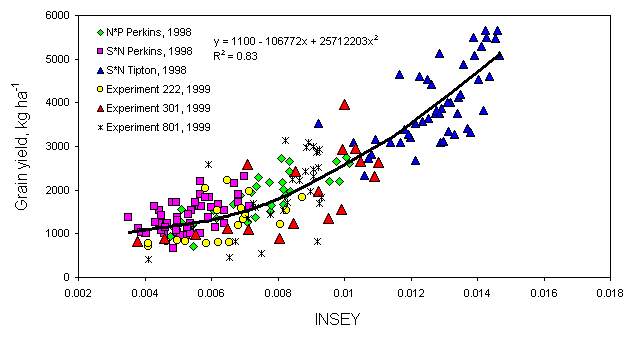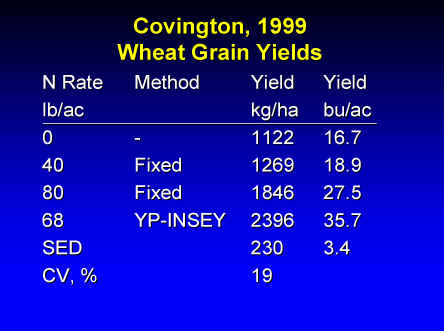 In-Season
Prediction of Yield Potential in Winter Wheat
(Better Crops: 85(4):6-8)
In-Season
Prediction of Yield Potential in Winter Wheat
(Better Crops: 85(4):6-8)Department of Biosystems and Agricultural Engineering
Oklahoma State University
Nitrogen fertilization rates in cereal production systems are generally determined by subtracting soil test N from a specified yield goal-based N requirement. In general, the yield goal represents the best achievable yield in the last four to five years. This method of determining N fertilization rates has gone largely unchanged over the last 25 years.
Our work has focused on predicting wheat grain yield potential using in-season spectral measurements collected from 1m2 areas between Feekes growth stages 4 and 5. At two locations where wheat was planted at different times, a modified normalized difference vegetative index (NDVI) was determined from multi-spectral reflectance measurements under daytime lighting {NDVI=[(NIR down/NIR up)-(Red down/Red up)/(NIR down/NIR up)+(Red down/Red up)]}.
estimated yield (EY) was computed using the sum of NDVI at Feekes 4 and NDVI at Feekes 5, divided by the growing degree days over that same time period. Grain yield was determined from the same plots where spectral reflectance readings were recorded during the growing season and regression analysis was used to evaluate various relationships.
EY versus Grain Yield
The relationship between wheat grain yield and EY computed from spectral reflectance readings collected at Feekes growth stages 4 and 5 is illustrated in Figure 1. Because NDVI was known to be correlated with plant biomass, the sum of NDVI at any two early physiological stages was expected to be an indicator of forage yield, growth rate and likely to be correlated with potential yield. The use of growing degree days in the computation of EY allowed us to consider both growing conditions and time (between the readings) and thus, the influence of growth rate.
The 1998 growing season was unique since adequate moisture was present at planting, and continued throughout the growing season. Only limited moisture stress was present, and both sites received timely rainfall near flowering. For this reason, yield and yield potential were expected to be similar, and thus why EY was highly correlated with grain yield. In general, we would not expect the EY index to be highly correlated with grain yield in all growing seasons since so many things can negatively impact the wheat crop from Feekes 4 to maturity. However, our interest was in developing a yield goal parameter that was "seasonal-sensitive", intrinsic, and that would more accurately reflect yield potential likely to be realized in that season. If growth was poor from planting to Feekes 5, it is unlikely that a high yield potential would be realized. Similarly, if growth was excellent from planting to Feekes 4, but declined from Feekes 4 to Feekes 5 (drought, frost damage, etc.), yield potential would be expected to be lower.
In-season estimates of yield potential need to be viewed as refined estimates of yield goal. We are presently evaluating topdress nitrogen fertilization rates based on the in-season estimate of yield potential. Nitrogen fertilizer rates are estimated using the following equation:
N rate = [(Predicted grain yield * % N in the grain) - (predicted forage N uptake at Feekes 5)]/0.70
where predicted grain yield was estimated from EY, % N in the grain obtained from average values associated with winter wheat at different yield levels (higher %N at low yield and lower %N at high yield), and predicted forage N uptake at Feekes 5 was based on the published relationship with NDVI. This method is aimed at increasing yield (recognizing the need for increased N rates in areas with increased yield potential) and N use efficiency (decreased N applied where forage N uptake was already high). Our work assumes that the production system allows for in-season application of fertilizer N, and that failing to apply preplant N has no adverse effect on grain yield. However, we recognize that using yield goals combined with soil NO3-N testing remains as one of the more useful tools in establishing fertilizer N rates when preplant fertilizer N application is the only option.
If yield potential can be reliably predicted, it will also have specific relevance when used as a decision making tool concerning herbicide use. In areas where yield potential is high, the affordability of applying herbicides should increase. Alternatively, areas with low yield potential will also be those where weed control will result in lowered economic gain. If the decision to apply herbicides in the same field were determined by yield potential, maximizing profit takes on a totally different meaning.
If accurate estimates of yield potential are to be realized, these estimates will be needed at resolutions (1m2) where differences in soil test parameters are found. If a coarser resolution (>30 m) is used, the variation in yield potential will be masked by averaging and benefits that may be realized in treating the variability can be lost. In summary, the use of EY offers an alternative method of refining topdress N rates by basing N fertilizer need on in-season prediction of yield potential.

Figure 1. Relationship between In-Season Estimated Yield (EY) computed from NDVI at Feekes growth stages 4 and 5, divided by growing degree days and observed grain yield, at six locations, 1998 and 1999.
The authors are researchers and members of the precision agriculture team at Oklahoma State University, Stillwater. The authors wish to thank J.M. LaRuffa, S.B. Phillips, J.L. Dennis, D.A. Cossey, M.J. DeLeon, C.W. Woolfolk, R.W. Mullen, B.M. Howell, and Jing Wang for their assistance with field and lab work.
